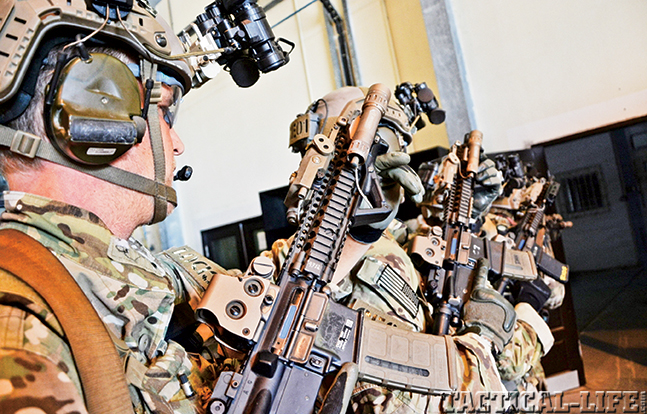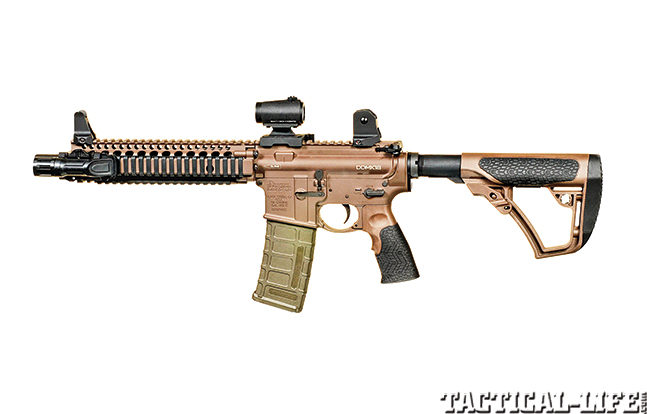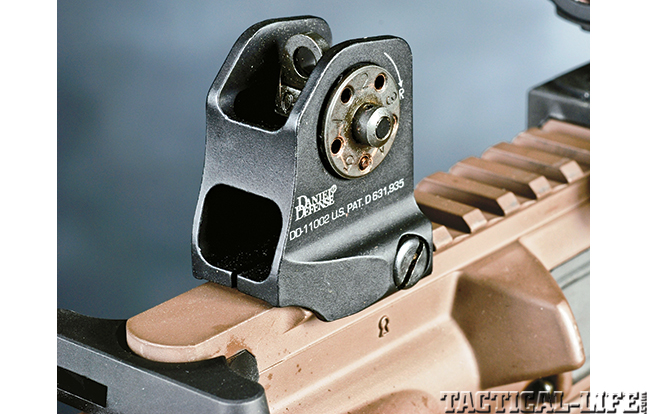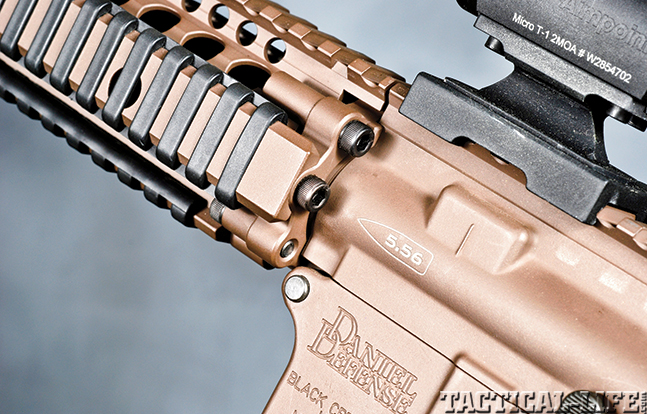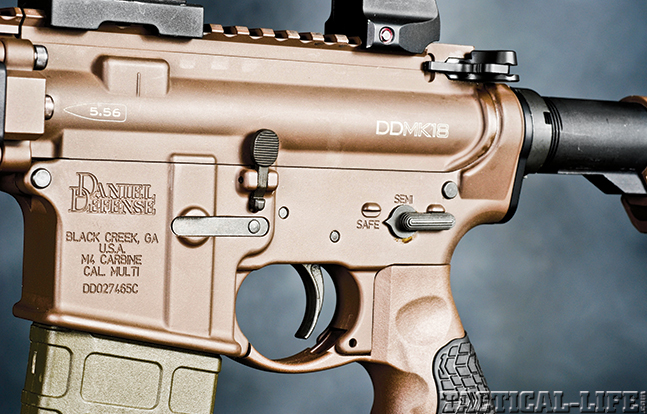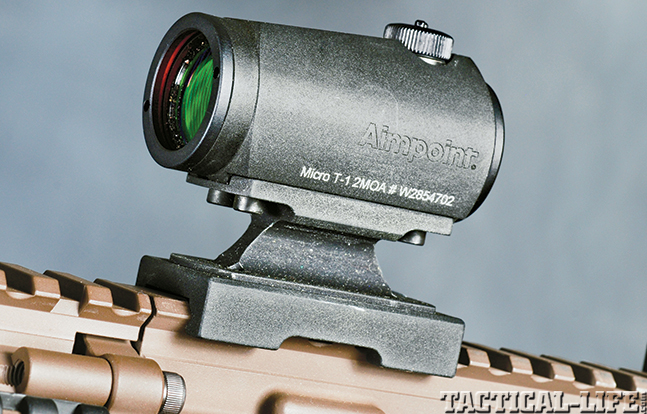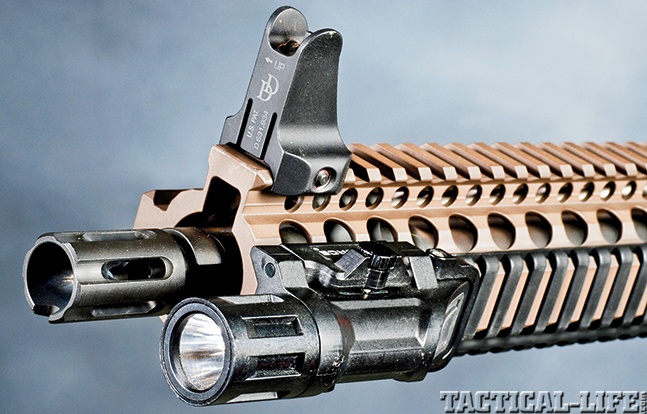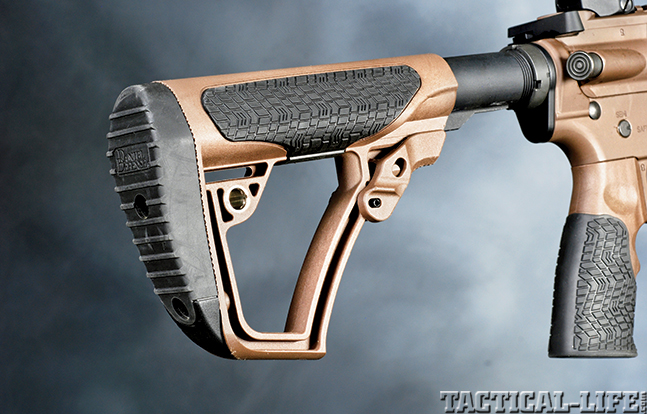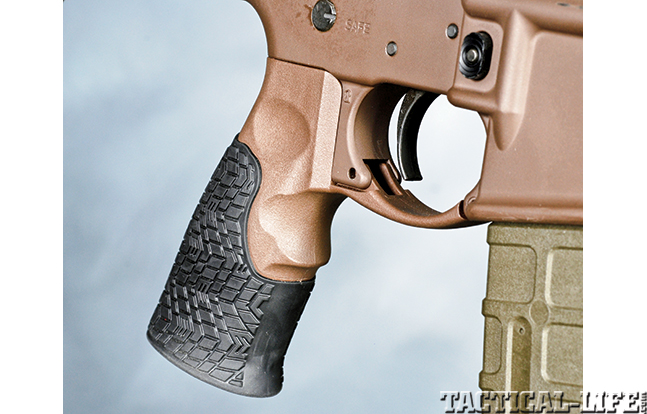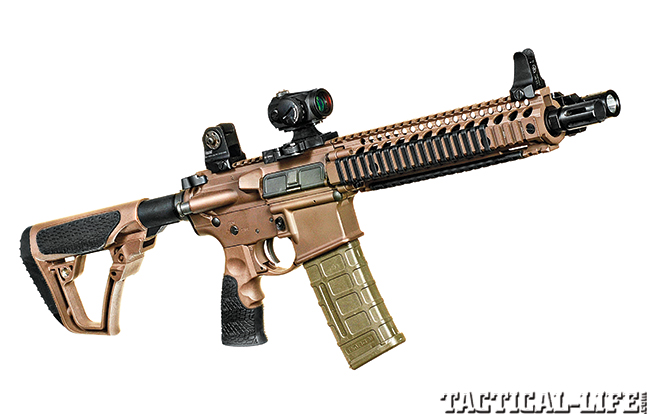I have been a fan of Daniel Defense rifles for several years. I’ve been fortunate to tour the company’s production and assembly plants in both Georgia and South Carolina. The history of the company is quite remarkable. Marty Daniel started it all with one product: a sling adaptor. Daniel Defense went on to design a Rail Interface System (RIS) handguard to meet a request from U.S. Special Operations Command (USSOCOM). More than 10 years later, Daniel Defense is still delivering RIS II rails to USSOCOM and other military units.
Daniel Defense’s slogan is “Stronger, Lighter, Better.” So, just how tough are Daniel Defense rifles? If you visit the company’s website or surf the net, you have probably seen the torture test video (danieldefense.com/torturetest). In the video, Larry Vickers takes a DDM4 carbine and buries it, sinks it, shoots it, runs it over, blows it up and drops it from a helicopter. After each evolution, the rifle was fired to test its accuracy and reliability. The results speak for themselves: Each time the rifle kept on running.
RELATED: Daniel Defense DDM4v7, MK12, V9 and MK18- New for 2014 |VIDEO
Advertisement — Continue Reading Below
Daniel Defense has built a reputation for being completely committed to quality. To that end, Daniel Defense manufactures nearly every component of its rifles in-house. This not only includes the barrels, the upper and lower receivers, bolts and fire control parts, but it also extends to the pins and detents. In addition, the company provides OEM parts to several other well-known manufacturers.
A quality barrel is at the foundation of every Daniel Defense rifle. All of its mil-spec barrels are cold-hammer forged through intense hydraulic pressure that is applied at opposing angles by carbide-steel hammers. During the hammering process, a mandrel is inserted into the bore. The hammers shape the barrel’s chamber, lands and grooves around the mandrel, creating a defect-free bore and a consistent chamber. Every barrel is magnetic-particle (MP) tested to ensure that there are no hidden flaws or fractures. In fact, Daniel Defense is one of only two U.S. companies that produce hammer-forged barrels, with the other being FNH USA.
Daniel Defense offers a wide selection of M4 rifles with pistol-, carbine- or mid-length gas systems. Being a fan of short-barreled rifles (SBRs), I was attracted to the company’s updated MK18. The MK18 is a clone of the carbine used by USSOCOM, and it features a 10.3-inch barrel. While the company offers select-fire rifles to government agencies, my test rifle was an NFA-approved semi-automatic. This allows the MK18 to be sold to any qualified buyer through the customer’s local FFL /SOT dealer.
Advertisement — Continue Reading Below
Gun Details
The MK18’s upper receiver is machined in-house to military specifications and is matched with a 10.3-inch barrel. The MK18 barrel is forged from chrome-moly-vanadium steel and is given a 1-in-7-inch twist rate and M4 feed ramps. The bore is chrome-lined, and the exterior is coated with a mil-spec phosphate. Every barrel is marked with identification markings that include the company’s initials, the method of rifling, the “MP” stamp for MP testing, the caliber, twist rate and “born on” date showing the month and the year. The bolt carrier group is also MP tested and has a properly staked gas key. The MK18 utilizes a carbine-length gas system. The flash suppressor assembly is a Daniel Defense design that will accept AAC Omni, Gemtech Halo and KAC NT-4 QDSS suppressors.
The MK18’s RIS II handguard is one of the lowest-profile quad-rails on the market today. This is accomplished by reducing the distance from the barrel to the rails at 3, 6 and 9 o’clock. The handguard is secured with six screws for easy installation and removal, and its top rail mates up perfectly with the flattop upper receiver’s for one long, continuous rail. The side rails are secured using three flat-head screws, and every other rail slot is numbered. The MK18 comes with three rail ladders and a Daniel Defense vertical foregrip.
Advertisement — Continue Reading Below
“The MK18 is a proven platform, and no one builds it better than Daniel Defense.”
The lower receiver on the MK18 is also machined to military specifications and features a quick-detach (QD) swivel attachment point for a single-point sling. The manufacturer’s markings have been engraved instead of roll marked. This gives the lower a very clean and crisp appearance. The magazine well is both enlarged and beveled for easier, faster reloads. The internals are mil-spec, and the trigger pull measures 7.25 pounds with the typical gritty take-up. However, the trigger break was clean and felt better than the trigger gauge indicated. I also noticed that the trigger got progressively better as I put more rounds through the rifle.
My test rifle came equipped with Daniel Defense’s optional fixed iron sights. These sights are manufactured out of aircraft-grade 6061-T6 aluminum and are then finished with a mil-spec hardcoat anodizing. The design of the sights minimizes the footprint on the top rail, allowing space for additional accessories. The front sight utilizes a sight post while the rear sight uses an A2 aperture with A1 adjustments. Wings protect both the front sight blade and the rear sight aperture. These are rugged sights that are designed to withstand hard use. While flip-up sights are the rave, I grew to like Daniel Defense’s fixed sights for their clean sight picture and compact design.
Advertisement — Continue Reading Below
This year, Daniel Defense introduced an OEM pistol grip and buttstock. The buttstock is designed with a modular buttplate that allows the user to select from two different shapes. The release lever is ergonomically designed for easy manipulation as well as ease in removing the buttstock. The stock’s soft cheek inserts are overmolded to provide a positive and comfortable cheekweld. The pistol grip also features overmolded inserts as well as an integral, oversized triggerguard and finger recesses. The Daniel Defense grip has a reduced angle that I found more comfortable than a mil-spec grip. Finally, the new MK18 is being offered in a new “Mil-Spec+” Cerakote brown finish. The finish is both attractive and practical for most operational environments.
Range Time
On the range, I broke the MK18 in using Hornady’s .223, 55-grain FMJ Training load. This training load is a low-cost alternative that is designed to deliver the same point of aim /point of impact as the Hornady TAP 55-grain tactical ammunition. Part of the cost savings come from the use of a lacquer-coated steel case and Berdan primer in the load. I have also found that this ammunition is exceptionally consistent and accurate.
Advertisement — Continue Reading Below
For 100-yard accuracy testing, I mounted my Leupold 2.5-8x36mm Mark 4 MR/T M2 scope in a LaRue SPR mount. The TMR reticle and brilliant light-gathering capabilities make the Mark 4 series of scopes ideal for the law enforcement community.
“The carbine is an ideal choice for law enforcement tactical teams and other end-users who require a quality, compact M4 Carbine.”
The Hornady Training round averaged 2,473 fps with an extreme spread of only 36 fps. The Training round produced a best five-shot group that measured 1.38 inches. The Hornady 55-grain TAP Urban load is specifically designed for use in short barrels, especially for high-risk environments where overpenetration is a primary concern. The TAP Urban averaged 2,535 fps and produced a 1.23-inch best group. The final test ammunition was Hornady’s 62-grain Barrier load, which averaged 2,457 fps and produced a best five-shot group of 1.09 inches.
Advertisement — Continue Reading Below
Everyone that handled and shot the MK18 at the range commented on its light weight and balance. I am not one who likes to put 10 pounds of accessories on a 6-pound rifle. Every duty rifle needs an optic, and there is no better optic than the Aimpoint Micro T-1 with a 2-MOA dot for CQB uses. The Micro T-1 is built with the same toughness as the CompM4, and a single CR2032 lithium battery powers it. Its advanced circuitry allows up to 50,000 hours of continuous use. Eight daylight settings and four night-vision settings give the Micro T-1 enhanced capabilities. I mounted the Micro T-1 using LaRue Tactical’s LT751 mount. While the iron sights tended to obstruct the view through the Micro T-1, there were no real issues when used as intended, with both eyes open.
Inforce is a relatively new company in the light market, but the company has earned the respect of some of the top tactical teams in the country. Its WML (Weapon Mounted Light) is one of the simplest and most effective lights on the market. The WML is a self-contained polymer weapon light that is only 4.1 inches in length and weighs a mere 3 ounces. The integral mount reduces both its profile and weight. A single CR123 lithim batter powers the WML’s 200-lumen LED. Its angled control switch—programmable and easy to manipulate—provides both momentary and constant-on beams and eliminates the need for tape switches. My test WML was a dual-output unit with both white and IR illumination.
The MK18 is a proven platform, and no one builds it better than Daniel Defense. The carbine is an ideal choice for law enforcement tactical teams and other end-users who require a quality, compact M4 Carbine. Those professionals who go into harm’s way trust Marty Daniel and Daniel Defense on a daily basis. That is an endorsement that can’t be bought—it is earned.
Advertisement — Continue Reading Below
For more information, visit danieldefense.com or call 866-554-4867.
